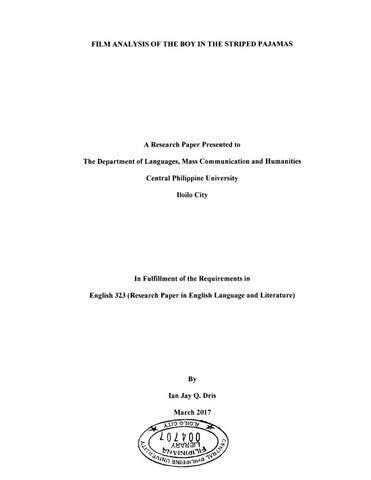Film analysis of The Boy in the Striped Pajamas
| dc.contributor.adviser | Cocjin, Annalee L. | |
| dc.contributor.author | Dris, Ian Jay Q. | |
| dc.date.accessioned | 2023-10-23T09:01:52Z | |
| dc.date.available | 2023-10-23T09:01:52Z | |
| dc.date.issued | 2017-03 | |
| dc.identifier.citation | Dris, I. J. Q. (2017). Film analysis of The Boy in the Striped Pajamas [Unpublished special paper]. Central Philippine University. | en_US |
| dc.identifier.uri | https://hdl.handle.net/20.500.12852/2851 | |
| dc.description | Abstract only | en_US |
| dc.description.abstract | This study is an analysis of a British historical period drama film, The Boy in the Striped Pajamas (2008) using Structuralism and Historical Approach. The movie is directed by Mark Herman based on the novel of the same name by the Irish writer, John Boyne. This study analyzed the characters based on their dialogues, identified the plots and extract samples lines and scenes which exemplify their historical relevance, identified the general themes, and determined the message incorporated in the film. Based on the analysis, the film has a postmodern, historical, fictional and dramatic genre. The Boy in the Striped Pajamas is a Holocaust drama that delves into the dread of a Nazi extermination camp during World War II manifested by the two eight-year-old boys; Bruno, son of the camp's Nazi commandant, and Schmuel, a Jewish inmate. The film put up a unique perspective on how hostility, prejudice, and hatred affect the innocence and curiosity of the people particularly children during wartime. The film simplified the portrayal of how horrid the Holocaust was, yet emphasized the functions of every event without deviating from the significance of the history. The main message of the film is about equality. Regardless of social status, gender, religious preference, sexual preference, or principles and beliefs, people are all the same and should be treated the same. This study is a crucial pedagogical tool that facilitates efficient learning and motivates participation from new generations of audiences. It can help audiences; ‘old’ and ‘new’, to rethink their place in the world, and crucially, it can also motivate them to do something about the injustices and exploitation to which they are witness. | en_US |
| dc.format.extent | v, 60 leaves | en_US |
| dc.language.iso | en | en_US |
| dc.subject.lcc | PN 73 .D75 2017 | en_US |
| dc.subject.lcsh | Film criticism | en_US |
| dc.subject.lcsh | Boy in the striped pyjamas (Boyne, John) | en_US |
| dc.subject.lcsh | Fiction | en_US |
| dc.subject.lcsh | World War (1939-1945) | en_US |
| dc.subject.lcsh | Nazis | en_US |
| dc.subject.lcsh | Jewish Holocaust (1939-1945) | en_US |
| dc.title | Film analysis of The Boy in the Striped Pajamas | en_US |
| dc.type | Special paper | en_US |
| dcterms.accessRights | Not publicly accessible | en_US |
| dc.description.bibliographicalreferences | Includes bibliographical references | en_US |
| dc.contributor.chair | Gotico, Sharlene | |
| dc.contributor.committeemember | Cagasan, Bernardo G. | |
| dc.contributor.department | Department of Languages, Mass Communication and Humanities | en_US |
| dc.description.degree | Bachelor of Arts major in English | en_US |


